�
Applied Biofluid
Mechanics
This page intentionally left blank
�
Applied Biofluid
Mechanics
Lee Waite, Ph.D., P.E.
Jerry Fine, Ph.D.
New York Chicago San Francisco Lisbon London Madrid
Mexico City Milan New Delhi San Juan Seoul
Singapore Sydney Toronto
�
Copyright © 2007 by The McGraw-Hill Companies, Inc. All rights reserved. Manufactured in the United
States of America. Except as permitted under the United States Copyright Act of 1976, no part of this pub-
lication may be reproduced or distributed in any form or by any means, or stored in a database or retrieval
system, without the prior written permission of the publisher.
0-07-150951-8
The material in this eBook also appears in the print version of this title: 0-07-147217-7.
All trademarks are trademarks of their respective owners. Rather than put a trademark symbol after every
occurrence of a trademarked name, we use names in an editorial fashion only, and to the benefit of the trade-
mark owner, with no intention of infringement of the trademark. Where such designations appear in this
book, they have been printed with initial caps.
McGraw-Hill eBooks are available at special quantity discounts to use as premiums and sales promotions,
or for use in corporate training programs. For more information, please contact George Hoare, Special Sales,
at george_hoare@mcgraw-hill.com or (212) 904-4069.
TERMS OF USE
This is a copyrighted work and The McGraw-Hill Companies, Inc. (“McGraw-Hill”) and its licensors reserve
all rights in and to the work. Use of this work is subject to these terms. Except as permitted under the
Copyright Act of 1976 and the right to store and retrieve one copy of the work, you may not decompile, dis-
assemble, reverse engineer, reproduce, modify, create derivative works based upon, transmit, distribute, dis-
seminate, sell, publish or sublicense the work or any part of it without McGraw-Hill’s prior consent. You may
use the work for your own noncommercial and personal use; any other use of the work is strictly prohibited.
Your right to use the work may be terminated if you fail to comply with these terms.
THE WORK IS PROVIDED “AS IS.” McGRAW-HILL AND ITS LICENSORS MAKE NO GUARAN-
TEES OR WARRANTIES AS TO THE ACCURACY, ADEQUACY OR COMPLETENESS OF OR
RESULTS TO BE OBTAINED FROM USING THE WORK, INCLUDING ANY INFORMATION THAT
CAN BE ACCESSED THROUGH THE WORK VIA HYPERLINK OR OTHERWISE, AND EXPRESSLY
DISCLAIM ANY WARRANTY, EXPRESS OR IMPLIED, INCLUDING BUT NOT LIMITED TO
IMPLIED WARRANTIES OF MERCHANTABILITY OR FITNESS FOR A PARTICULAR PURPOSE.
McGraw-Hill and its licensors do not warrant or guarantee that the functions contained in the work will meet
your requirements or that its operation will be uninterrupted or error free. Neither McGraw-Hill nor its licen-
sors shall be liable to you or anyone else for any inaccuracy, error or omission, regardless of cause, in the
work or for any damages resulting therefrom. McGraw-Hill has no responsibility for the content of any infor-
mation accessed through the work. Under no circumstances shall McGraw-Hill and/or its licensors be liable
for any indirect, incidental, special, punitive, consequential or similar damages that result from the use of or
inability to use the work, even if any of them has been advised of the possibility of such damages. This lim-
itation of liability shall apply to any claim or cause whatsoever whether such claim or cause arises in con-
tract, tort or otherwise.
DOI: 10.1036/0071472177
�
ABOUT THE AUTHORS
LEE WAITE, PH.D., P.E., is Head of the Department of
Applied Biology and Biomedical Engineering, and Director
of the Guidant/Eli Lilly and Co. Applied Life Sciences
Research Center, at Rose-Hulman Institute of Technology in
Terre Haute, Indiana. He is also the author of Biofluid
Mechanics in Cardiovascular Systems, published by
McGraw-Hill.
JERRY FINE, PH.D., is Associate Professor of Mechanical
Engineering at Rose-Hulman Institute of Technology.
Before he joined the faculty at Rose, Dr. Fine served as
a patrol plane pilot in the U.S. Navy and taught at the
U.S. Naval Academy.
Copyright © 2007 by The McGraw-Hill Companies, Inc. Click here for terms of use.
�
This page intentionally left blank
�
For more information about this title, click here
Contents
Preface
Acknowledgments
xiii
xv
Chapter 1. Review of Basic Fluid Mechanics Concepts
1.1 A Brief History of Biomedical Fluid Mechanics
1.2 Fluid Characteristics and Viscosity
1.2.1 Displacement and velocity
1.2.2 Shear stress and viscosity
1.2.3 Example problem: shear stress
1.2.4 Viscosity
1.2.5 Clinical feature: polycythemia
1.3 Fundamental Method for Measuring Viscosity
1.3.1 Example problem: viscosity measurement
1.4 Introduction to Pipe Flow
1.4.1 Reynolds number
1.4.2 Example problem: Reynolds number
1.4.3 Poiseuille’s law
1.4.4 Flow rate
1.5 Bernoulli Equation
1.6 Conservation of Mass
1.6.1 Venturi meter example
1.7 Fluid Statics
1.7.1 Example problem: fluid statics
1.8 The Womersley Number α: A Frequency Parameter for Pulsatile Flow
1.8.1 Example problem: Womersley number
Problems
Bibliography
Chapter 2. Cardiovascular Structure and Function
2.1 Introduction
2.2 Clinical Features
2.3 Functional Anatomy
2.4 The Heart as a Pump
2.5 Cardiac Muscle
2.5.1 Biopotential in myocardium
1
1
6
7
8
10
11
13
14
16
16
17
19
19
23
24
24
26
27
28
29
30
31
33
35
35
36
37
38
39
40
vii
�

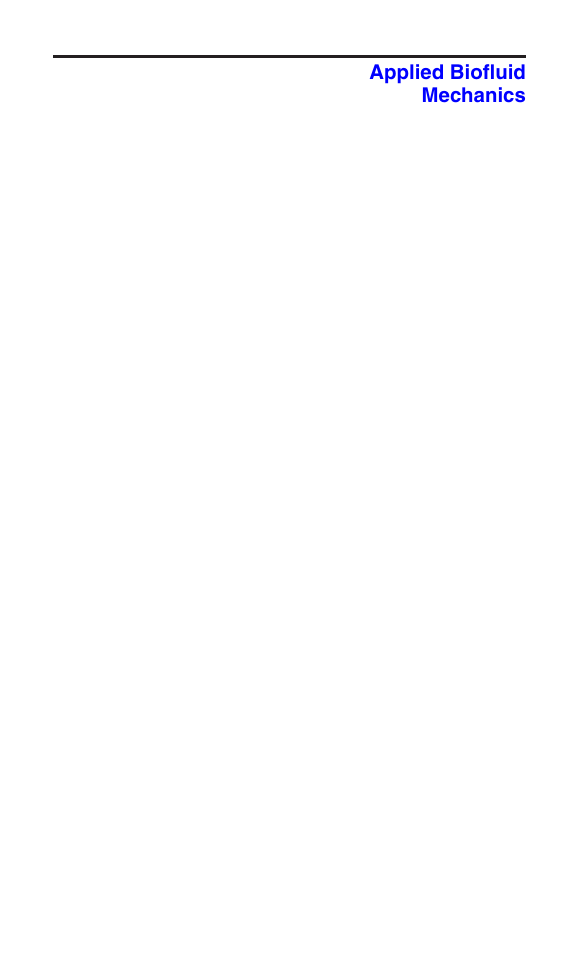
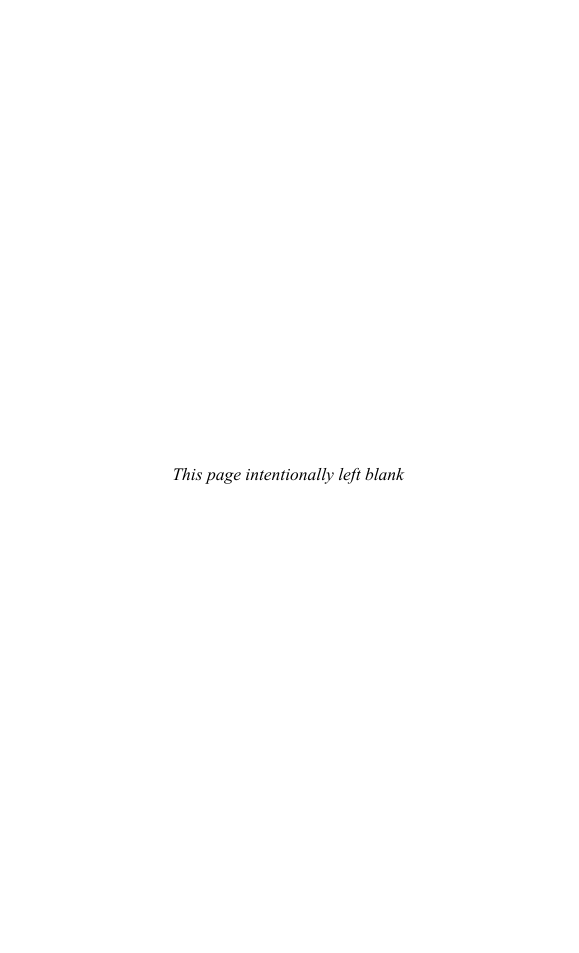
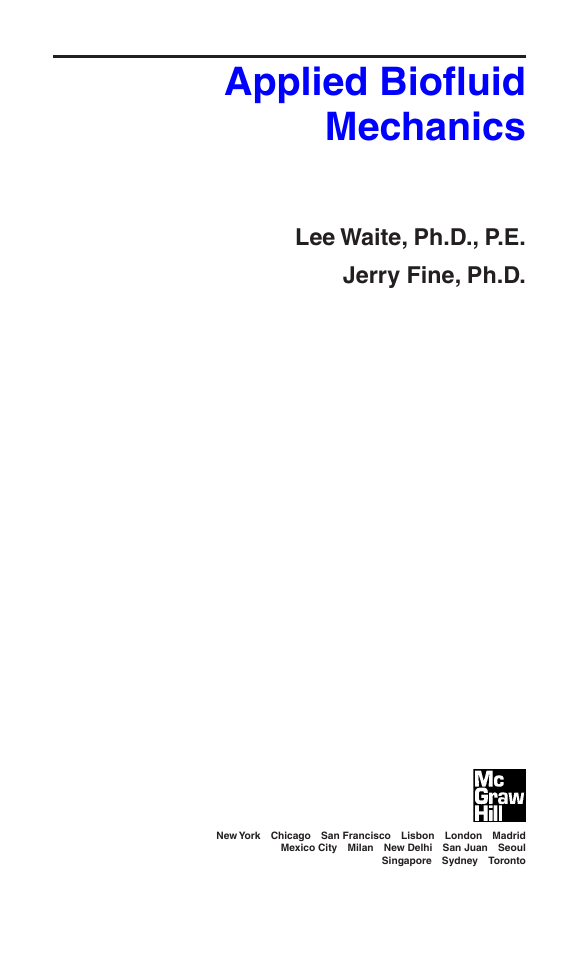
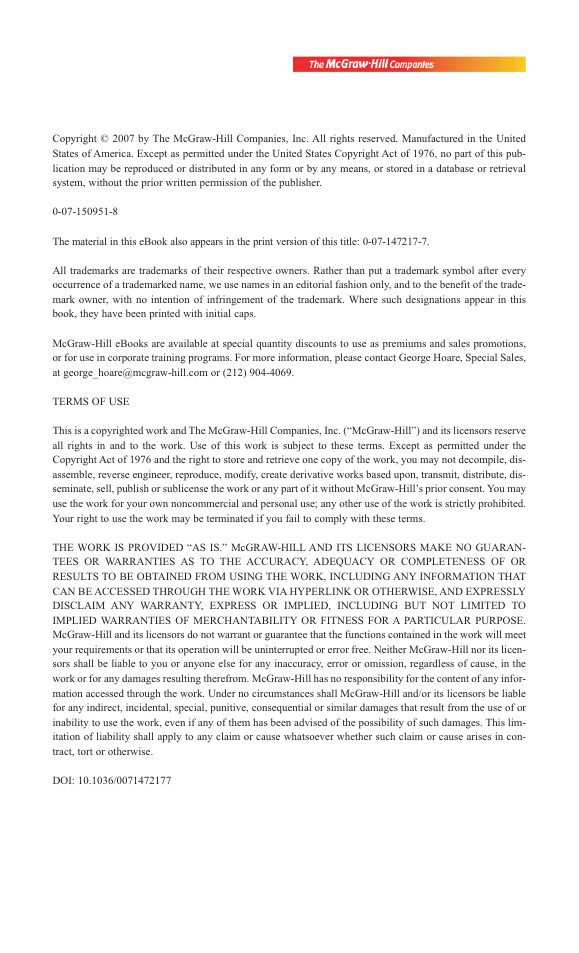
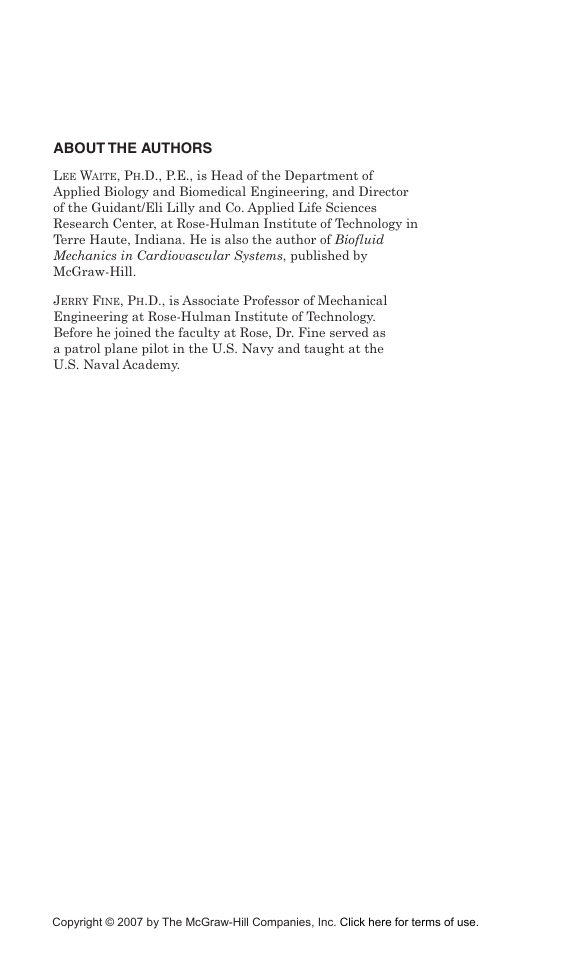
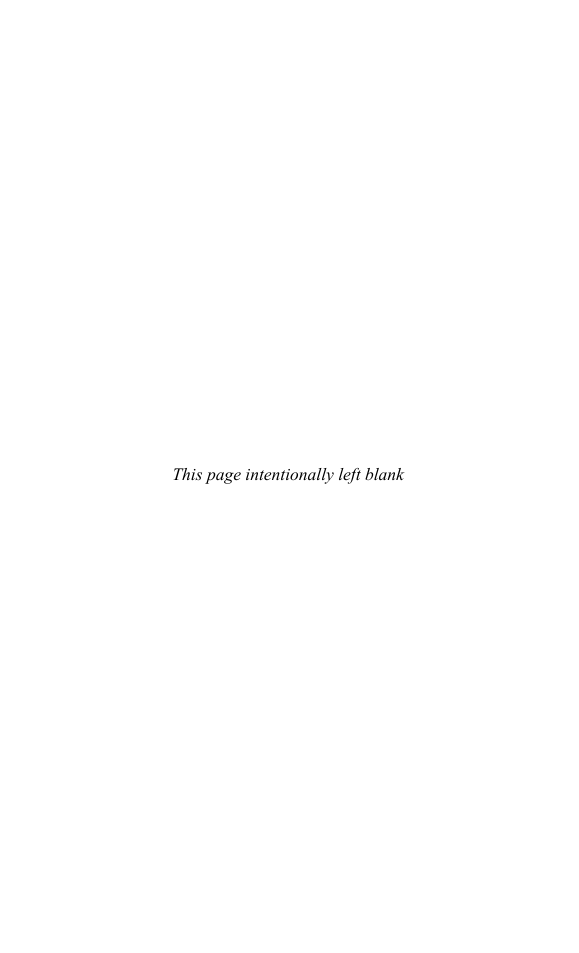
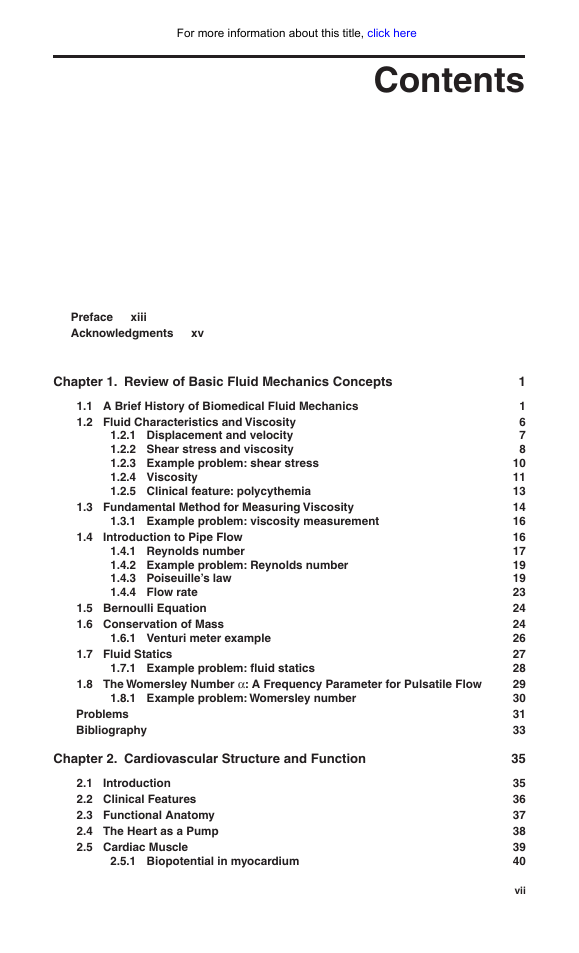








 2023年江西萍乡中考道德与法治真题及答案.doc
2023年江西萍乡中考道德与法治真题及答案.doc 2012年重庆南川中考生物真题及答案.doc
2012年重庆南川中考生物真题及答案.doc 2013年江西师范大学地理学综合及文艺理论基础考研真题.doc
2013年江西师范大学地理学综合及文艺理论基础考研真题.doc 2020年四川甘孜小升初语文真题及答案I卷.doc
2020年四川甘孜小升初语文真题及答案I卷.doc 2020年注册岩土工程师专业基础考试真题及答案.doc
2020年注册岩土工程师专业基础考试真题及答案.doc 2023-2024学年福建省厦门市九年级上学期数学月考试题及答案.doc
2023-2024学年福建省厦门市九年级上学期数学月考试题及答案.doc 2021-2022学年辽宁省沈阳市大东区九年级上学期语文期末试题及答案.doc
2021-2022学年辽宁省沈阳市大东区九年级上学期语文期末试题及答案.doc 2022-2023学年北京东城区初三第一学期物理期末试卷及答案.doc
2022-2023学年北京东城区初三第一学期物理期末试卷及答案.doc 2018上半年江西教师资格初中地理学科知识与教学能力真题及答案.doc
2018上半年江西教师资格初中地理学科知识与教学能力真题及答案.doc 2012年河北国家公务员申论考试真题及答案-省级.doc
2012年河北国家公务员申论考试真题及答案-省级.doc 2020-2021学年江苏省扬州市江都区邵樊片九年级上学期数学第一次质量检测试题及答案.doc
2020-2021学年江苏省扬州市江都区邵樊片九年级上学期数学第一次质量检测试题及答案.doc 2022下半年黑龙江教师资格证中学综合素质真题及答案.doc
2022下半年黑龙江教师资格证中学综合素质真题及答案.doc